The Feast of the Epiphany
January 5, 2020We learn from the Gospel of Luke that the first people to visit the newborn child, Jesus, were shepherds, Jewish men, sent by angels.
 They left their flocks and found the newborn child in the stable of a Bethlehem inn. They were filled with great joy and returned to their sheep, loudly praising God and announcing to all and sundry what they had seen and heard.
They left their flocks and found the newborn child in the stable of a Bethlehem inn. They were filled with great joy and returned to their sheep, loudly praising God and announcing to all and sundry what they had seen and heard.
Traditionally, on the feast of the Epiphany, we celebrate another group of visitors. This time the story is told in the Gospel of Matthew. From the east came some wise men, astronomers, who had seen a new star rising that they interpreted as being the portent of the birth of a great king. They followed that star as it went before them and led them to Jerusalem where they began questioning the populace thus: In what great house would they find the newborn king of the Jews?
This question caused consternation and word of the strangers’ quest passed from person to person until it reached the ears of King Herod. Herod, of course, saw a rival. He summoned the wise men and gave them instructions to return to him when they found this child and he, too, would go and pay him homage. Not likely!
Learning that the prophets had foretold Bethlehem as being the place where they would find the child they were looking for, the wise men left Jerusalem. Immediately, the star reappeared and went before them to Bethlehem and to the house where they found the child. They paid homage to him and presented their gifts of gold, frankincense and myrrh. Then these wise men, non-Jews, were warned in a dream not to return to Herod but to go home by another route.
What is the message for us in this story? The wise men followed the star and it brought them to the end of their quest. Do we each have a star that compels us to follow it to find our goal in life? Do we keep that star before us even though the journey may be hard and full of difficulties and setbacks? Nevertheless, the end of the journey brings us to the goal of all our longings.
What is the goal of all our longings? That question is for each one of us to answer. But may we, like the wise men, be lead to the place where we will find Jesus, our Emmanuel – God with us.
Bernadette O’Sullivan rsj
Image: Christmas Kings Time obtained from Pixabay. Used with permission.
New Year 2020
January 1, 2020Congregational Leader Sr Monica Cavanagh, provides us with a message for the New Year 2020…
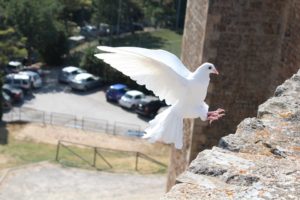 Greetings as we step over into the threshold of a New Year. May 2020 be filled with many moments of blessing and opportunities to celebrate the gift of life.
Greetings as we step over into the threshold of a New Year. May 2020 be filled with many moments of blessing and opportunities to celebrate the gift of life.
As we welcome the New Year, we do so with hearts filled with deep hope and trust that each day of 2020 will open the door to new pathways of love. It calls us to be generous in our response to those in need, to those burdened by the realities of hardship and to be welcoming to the newcomer and the stranger in our midst.
New Year also marks a day when Pope Francis shares a World Day of Peace message. This year he invites us to ponder and consider the theme: ‘Peace as a Journey of Hope: Dialogue, Reconciliation and Ecological Conversion’. By engaging in each aspect of this theme, Pope Francis says:
As we celebrate this New Year, let us commit ourselves to be instruments of peace, love and justice. Let us open ourselves to the opportunities that will be ours to make the world a more hopeful and loving place for all. May we bear witness to the all embracing love of God that continually flows freely and gratuitously in the great web of life.
Blessings as you celebrate the gift of a New Year. May the dreams you hold come to birth and may you find in each day a moment of gratitude.
Sr Monica Cavanagh
Congregational Leader
[1] Pope Francis’ Message for the celebration of the 53rd World Day of Peace. 1 January, 2020.
Image: Bird Dove of Peace obtained from Pixabay. Used with permisison.
Christmas Greetings
December 25, 2019Greetings on this Christmas Day.
May peace and joy be yours as you celebrate with family and friends and remember the gift of that first Christmas day. Let us also pause and remember those for whom this Christmas will be difficult.
Here in Australia, we are very mindful of all those who have suffered in the recent bush fires and those in our rural communities living through one of the most devasting droughts of this era. Across our world we are mindful of all those who are left homeless through poverty; those living in refugee camps; the first nations peoples of the world seeking recognition and respect for their traditions and those working to address the many unjust circumstances that arise out of misuse of power. In such realities, we might be prompted to ask: “Where do we see the events of the Christmas story happening in our world today?”
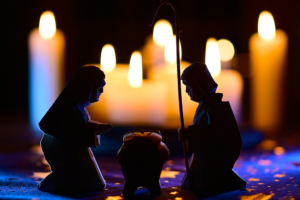 The stable where Christ is born is to be found in the many refugee camps of the world. The shepherds represent the many women and men who work tirelessly to bring peace across our world. The innkeeper is like us when we can be so overwhelmed by the many calls on our time that we fail to hear the knock on the door of our hearts to be more compassionate and open to the needs of our world. We see the joy of Mary and Joseph as parents welcome their newborn child. Our hearts and minds are stretched by the many people who invite us to widen our tents like the wise men from the East. Each character within the story invites us to explore within ourselves what it means to be the hands and feet and heart of Christ in our world today. This Christmas, let us be attentive to those many places where the vision of the Christ Child is being born today in the generous self-giving of those whose lives are inspired by the story of the first Christmas. Let us celebrate the giftedness of each person we encounter on this Christmas day.
The stable where Christ is born is to be found in the many refugee camps of the world. The shepherds represent the many women and men who work tirelessly to bring peace across our world. The innkeeper is like us when we can be so overwhelmed by the many calls on our time that we fail to hear the knock on the door of our hearts to be more compassionate and open to the needs of our world. We see the joy of Mary and Joseph as parents welcome their newborn child. Our hearts and minds are stretched by the many people who invite us to widen our tents like the wise men from the East. Each character within the story invites us to explore within ourselves what it means to be the hands and feet and heart of Christ in our world today. This Christmas, let us be attentive to those many places where the vision of the Christ Child is being born today in the generous self-giving of those whose lives are inspired by the story of the first Christmas. Let us celebrate the giftedness of each person we encounter on this Christmas day.
As we pray with those who are struggling in our world today let us be encouraged by these words of Isaiah 11:1 that:
So too on this Christmas day, we celebrate the many women and men who provide a word of hope or an action of love that bears fruit like the many fire-fighters in our country, or the groups organising Christmas packs for women in rural communities. In our world, we see and hear stories of love at the borders where women and men are seeking refugee; the encouragement given to the Indigenous communities at the Amazonian Synod; the voices of those seeking freedom from oppressive regimes and the simple acts of neighbourliness shared in so many ways. These stories are the Christmas story told once again.
Sr Monica Cavanagh rsj
Congregational Leader
A Prayer in a Time of Drought
December 24, 2019As we celebrate this Christmas Season may we be mindful of our burning Mother Earth…
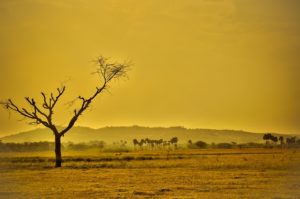 Creative and nurturing God,
Creative and nurturing God,
we weep in the face of dry land and fire,
dying crops and animals,
traumatised families and communities.
Our land evolved in Your wisdom over eons.
Some people learned to live within its boundaries
prospering from its fruitfulness, and in humility
responded with gratitude and praise for its gifts.
Often with good intentions,
we have imposed our ideas of progress and prosperity
demanding lifestyle benefits and production
that push the land beyond its capacities.
Teach us to listen to the land with humility.
Send the Spirit of Jesus to teach us respect.
Guide us to be co-creators with your divine providence.
Fill our hearts with patience and compassion.
May we commit ourselves to face the calamity of drought,
city and rural cooperating as one in service and generosity,
planning with leaders to create a sustainable future, so that
we can again love the beauty of Your land fully alive. (Rev. Dr. Charles Rue).
Ann Morrison rsj
Image: Dry arid yellow obtained from Pixabay. Used with permission.
Ego to Eco: Part One
December 23, 2019Father Julian Tenison Woods was a Catholic priest who had made a great contribution to Australian Geology, Botany, Palaeontology and Zoology.
Today the ecology of the Earth is suffering. Pope Francis states that we are in a time where peoples of the world need to have an ‘ecological conversion.’
Although Father Julian had lived in a different time to us, he had recognised the importance of looking after the Earth.
Opening of Mary MacKillop Museum in Adelaide
December 11, 2019Honouring Saint Mary and Her Legacy: Adelaide’s Newest Museum
 Grey skies and wild winds could not dampen the excitement and delight that were so evident amongst the 320 guests who gathered at Mary MacKillop College in Kensington on 1 December to witness the reopening of the adjoining Mary MacKillop Museum, which had been closed for redevelopment since late 2015. Originally commissioned as a Josephite Sesquicentenary project, the redevelopment and extension of the Museum took longer than was first anticipated. The delays and disappointments, however, paled into insignificance as the Sisters and all present at this memorable event celebrated the transformation that had taken place in recent months and which has produced a contemporary, inviting space that is interactive, reflective and inspirational.
Grey skies and wild winds could not dampen the excitement and delight that were so evident amongst the 320 guests who gathered at Mary MacKillop College in Kensington on 1 December to witness the reopening of the adjoining Mary MacKillop Museum, which had been closed for redevelopment since late 2015. Originally commissioned as a Josephite Sesquicentenary project, the redevelopment and extension of the Museum took longer than was first anticipated. The delays and disappointments, however, paled into insignificance as the Sisters and all present at this memorable event celebrated the transformation that had taken place in recent months and which has produced a contemporary, inviting space that is interactive, reflective and inspirational.
During the opening ritual, the unveiling of the Commemorative Plaque was shared by Sister Monica Cavanagh, Congregational Leader of the Sisters of Saint Joseph and His Excellency, Governor Hieu Van Le, Governor of South Australia.
Sister Monica reminded guests that the Museum is situated “on the sacred ground where Mary MacKillop lived, walked, worked, prayed, laughed and anguished from 1872 to 1883.” She expressed her hope that this will, once again, be a place of education and pilgrimage, where visitors will engage in, and be inspired by, the story that shaped Mary MacKillop into the courageous, ground-breaking woman Australians have come to know and love.
Governor Hieu Van Le, an ardent admirer of Mary MacKillop, spoke of her from his own perspective, naming why she inspires him, especially her resilience, and why she is so significant for Australians of all background:
Adelaide’s Apostolic Administrator, Bishop Greg O’Kelly, who blessed the Commemorative Plaque, linked a line from Psalm 127: ‘If our God does not build the house, then in vain do the builders labour…’ with a letter written by Mary 25 years after the Josephites’ humble beginnings in Penola. Then, she wrote to her Sisters: ‘Little did either of us then dream of what was to spring from so small a beginning…’ a theme which is threaded through the redeveloped Museum. In Bishop O’Kelly’s estimation, the new Mary MacKillop Museum ‘moves the heart and lifts the soul.’
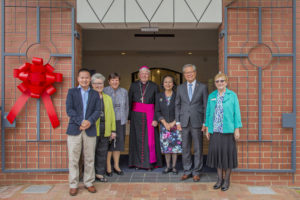 In her vote of thanks, the Regional Leader for CentreWest, Sister Margaret Cleary, acknowledged and thanked the many people who had contributed in any way to the Museum’s redevelopment, which was steered by Sister Mary Ryan, and the multi-skilled members of the Task Force who had invested so much of their time, talents, passion and personal resources in this project over the last four years. The hard work and initiative of the Fund-raising Committee, headed by Sister Brigette Sipa, were also recognised, along with the researchers, writers and editors, the architects, designers and skilled people who had combined forces to create a beautiful, welcoming, educational and spiritual ambience for visitors.
In her vote of thanks, the Regional Leader for CentreWest, Sister Margaret Cleary, acknowledged and thanked the many people who had contributed in any way to the Museum’s redevelopment, which was steered by Sister Mary Ryan, and the multi-skilled members of the Task Force who had invested so much of their time, talents, passion and personal resources in this project over the last four years. The hard work and initiative of the Fund-raising Committee, headed by Sister Brigette Sipa, were also recognised, along with the researchers, writers and editors, the architects, designers and skilled people who had combined forces to create a beautiful, welcoming, educational and spiritual ambience for visitors.
This new Museum goes beyond telling a little of Mary’s story. We also encounter a band of her courageous early companions who enabled the Josephite story to develop in ways and places that Mary and Julian could never have imagined. We can follow their inspiring stories via the digital display kiosks dotted round the Museum’s galleries. Using SoundPens, we are also able to hear the voices of Mary, Julian, pioneering Sisters, and also people – Sisters and others with Josephite hearts – representing the countless others who have kept the Penola dream alive as they have worked, in myriad ways, to make their small part of the world a better, more just place.
Other highlights of the new Museum include display boards, historic photos and letters, relics, art works, artefacts and memorabilia from various aspects of the 153 year-old Josephite story. All are now evoking visitors’ memories and/curiosity!
The Sisters of Saint Joseph invite you to visit Mary MacKillop Museum Adelaide. On arrival, you will be welcomed as you embark on a journey of discovery and inspiration. This is no ordinary museum! There is something to touch the hearts of visitors of all ages, cultures and faith backgrounds!
Mary MacKillop Museum Adelaide, which includes a Gift Shop and a soon-to-be-opened Café, is open 6 days a week. It is closed on Mondays, and between Christmas and New Year, reopening on 2 January 2020.
Information:
Address: 19 Phillips Street, Kensington SA
Opening Hours: 10.00am. to 4.00pm. Closed Christmas (25 December 2019) to New Year (1 January 2020).
Enquiries: info.mmprecinct@sosj.org.au or (08) 8130 5910
Website: www.marymackillopadelaide.org.au/museum
Group bookings: infosa@sosj.org.au or 08 8130 5900
View photos from the opening in the gallery below:
Photos: Sarah-Jane and Eric van Staden: Inhouse Imaging www.inhouseimaging.com.au. Used with permission.
Inspiring ‘Spiritual Meadow’ Art Show Raises Funds
December 9, 2019St Joseph’s by the Sea in Williamstown, Victoria (SJBTSW) hosted a contemporary art show recently and we are thrilled to announce it was a huge success.
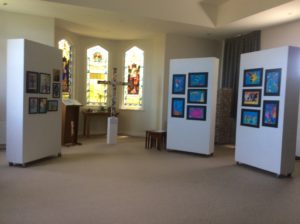
The exhibition which was part of St Joseph’s by the Sea Prayer and Spirituality Program for 2019 and it featured the works of some famous local artists including illustrator John Spooner, painter Katsuya, local historian and artist Carmel Taig, our very own Sr Therese Quinn and a selection of artworks from St Mary’s Primary School and Mount Saint Joseph’s Girl’s College. Also featured were works from Aboriginal artists Melissa Bricknell, Doug Smith and Lorraine Nelson.
More than 150 people, local residents in Williamstown and beyond, attended the three day exhibition and listened to talks from artists featured in the show.
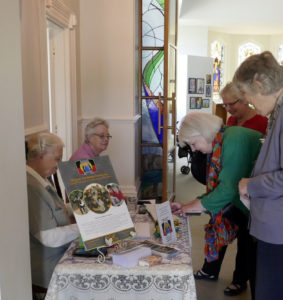
The title for the exhibition, The Spiritual Meadow, is taken from the translated title of a manuscript written by the Byzantium monk, John Moschus, who made a pilgrimage about the Eastern Mediterranean region collecting stories from monks and solitaries providing an intriguing portrayal of sixth century monastic spirituality.
For this program, artists were invited to contribute works that ‘moved them spiritually’.
Funds raised went to supporting Aboriginal and Torres Strait Islander Education through the ‘Opening the Doors Foundation’.
The show was so successful that the Prayer and Spirituality Program committee has decided to hold another Art Exhibition at the end of 2020.
Josephine Cafagna
Member of the Prayer and Spirituality Planning Team
A reflection on the Exhibition by a participant:
The Spiritual Meadow, the recent Art Exhibition at St Joseph’s by the Sea, was a fitting ending to the Prayer and Spirituality programme of 2019 where the emphasis has been on the profound relationship between the arts and spirituality. “What moves us?” was the recurring theme as literature, music and art were examined.
All who attended The Spiritual Meadow were deeply moved – some by simply contemplating each piece of art, others by hearing Robina Astley, the curator of the exhibition, and Melissa Brickell speak of the provenance of their pieces and the spirituality of the creative experience as artists. Melissa revealed her catholic/aboriginal spirituality and its all-encompassing role in her painting. Robina encouraged several other artists to speak about their pieces. Sr Therese Quinn and Ingrida Rocis were two such artists. Ingrida also explained how the beautiful ceramic pieces, ‘Mother’s Love’ created by her daughter had come from a dark and painful place. As one who was at the exhibition and heard all these artists speak with such great honesty and integrity I feel profoundly privileged to have been there.
Mary Debenham
Member of the Prayer and Spirituality Planning Team
Visit the ‘Opening the Doors Foundation’ website
View photos in the gallery below:
Photos provided by Patricia Williamson. Used with permission.
Year of Indigenous Languages: Hindi and Filipino
The United Nations has declared 2019 as the International Year of Indigenous Languages. To celebrate, for each month this year, you’re invited to view greetings for different languages.
To conclude the ‘Year of Indigenous Languages’, we feature the languages Hindi and Filipino:
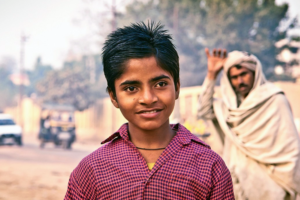 Hindi
Hindi
शुभ प्रभात!
आज आप कैसे हैं?
भगवान आपका भला करे!
shubh prabhaat!
aaj aap kaise hain?
bhagavaan aapaka bhala kare!
Good Morning!
How are you today?
May God Bless you!
Filipino
Nasa Diyos ang awa, nasa tao ang gawa. – With God is mercy, with man is action. God gives mercy to those who help themselves.
Ang nagmamataas ay ibababa, at ang nagpapakumbaba ay itataas. – Humble yourselves before the Lord, and He will lift you up. (From Matthew 23:12 “For whoever exalts himself will be humbled, and whoever humbles himself will be exalted.”)
Photo: Boy in India obtained from pxhere. Used with permission.
